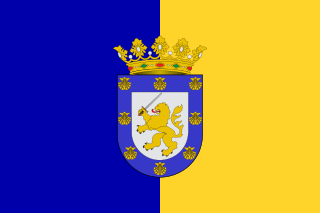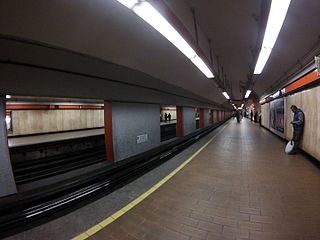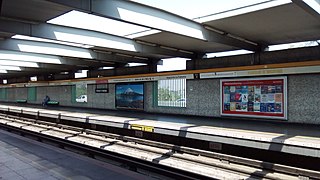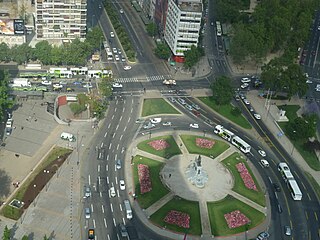
Santiago, also known as Santiago de Chile, is the capital and largest city of Chile as well as one of the largest cities in the Americas. It is the center of Chile's most densely populated region, the Santiago Metropolitan Region, whose total population is 8 million, of which more than 6 million live in the city's continuous urban area. The city is entirely in the country's central valley. Most of the city lies between 500–650 m (1,640–2,133 ft) above mean sea level.

Tacubaya is a station on Lines 1, 7 and 9 of the Mexico City Metro system. It is located in the Miguel Hidalgo borough, west of the city centre. In 2019, the station had a total average ridership of 85,800 passengers per day, making it the fifth busiest station in the network.

Constituyentes is a station on Line 7 of the Mexico City metro on the western outskirts of the city center. It serves Chapultepec Park and numerous attractions therein, as well as the Luis Barragán House and Studio. The station opened on 23 August 1985.

Mexico City Metro Line 1 is one of the twelve metro lines operating in Mexico City, Mexico. Officially inaugurated in 1969, it went to become the first metro line to be built in the country. Its identifying color is pink and it runs through the city from west to east.

Quinta Normal Park is an urban park in the city of Santiago, Chile. The park is in a commune, or district of the same name, Quinta Normal. The park is bounded by Matucana Avenue to the east, Portales Avenue to the south and Santo Domingo Street to the north. It is home to several museums, including the Chilean National Museum of Natural History. Near the park is the Museum of Memory and Human Rights. The park is also near a public library.

Line 12, also known as the Golden Line from its color on the system map, is a temporarily closed rapid transit line of the Mexico City Metro network. It travels 25.1 kilometers (15.6 mi) along the boroughs of Benito Juárez, Iztapalapa and Tláhuac in southwestern, central-southern and southeastern Mexico City, serving twenty stations. The line was inaugurated on 30 October 2012, going from Tláhuac to Mixcoac station. In 2016, work to expand it to Observatorio station started.

Parque O'Higgins is a metro station on the Line 2 of the Santiago Metro, in Santiago, Chile. It is located in the middle of the east branch of the Autopista Central, on a raised embankment, just prior to an elevated viaduct that crosses Matta avenue. The station is named for the adjacent Parque O'Higgins, located west of the station.

Bellas Artes is an underground metro station on the Line 5 of the Santiago Metro. It has platforms narrower than those of the older Santiago's metro stations and has only one exit. Chilean National Museum of Fine Arts, which is located on Parque Forestal, and Santa Lucía Hill are within walking distance from the station. The station was opened on 3 March 2000 as part of the extension of the line was extended from Baquedano to Santa Ana.

Plaza Baquedano, commonly known as Plaza Italia, is a major landmark in Santiago, Chile.

Bustamante Park is an urban park in Providencia, Santiago de Chile. It is built on the former site of Pirque railroad station and adjacent classification yard. The park is bounded by Providencia Avenue on the north, just south of Plaza Baquedano, and Marín Street on the south.

Pedro de Valdivia is an underground metro station on the Line 1 of the Santiago Metro, in Santiago, Chile. The station is named for the nearby Pedro de Valdivia Avenue, which in turn was named for Pedro de Valdivia. It was opened on 22 August 1980 as part of the extension of the line from Salvador to Escuela Militar.

República is an underground metro station on the Line 1 of the Santiago Metro, in Santiago, Chile. This station is named for República Avenue. The station was opened on 15 September 1975 as part of the inaugural section of the line between San Pablo and La Moneda.

Universidad de Santiago is an underground metro station on the Line 1 of the Santiago Metro, in Santiago, Chile. Is named for the nearby University of Santiago. The station is adjacent to the Evangelical Cathedral of Santiago and to the main bus stations in the city. It was opened on 15 September 1975 as part of the inaugural section of the line between San Pablo and La Moneda.

Santa Isabel is a metro station on Line 5 of the Santiago Metro, in Santiago, Chile. It takes its name from its location beneath the intersection of Avenida General Bustamante with Avenida Santa Isabel, the intersection that delineates the communes of Providencia, Ñuñoa and Santiago. The station is located underground, between the stations Parque Bustamante to the north and Irarrázaval to the south. The station was opened on 5 April 1997 as part of the inaugural section of the line, from Baquedano to Bellavista de La Florida.

Irarrázaval is a transfer station between the Line 3 and Line 5 of the Santiago Metro. The station is so named due to its location beneath Avenida Irarrázaval, a main road of the commune of Ñuñoa, which in turn was named after the Chilean lawyer and politician Manuel José Yrarrázaval Larraín. The Line 5 station was opened on 5 April 1997 as part of the inaugural section of the line, from Baquedano to Bellavista de La Florida. The Line 3 station was opened on 22 January 2019 as part of the inaugural section of the line, from Los Libertadores to Fernando Castillo Velasco. Construction of the 6.5 km tunnel between Irarrázaval and Fernando Castillo Velasco was completed in 2017 on a budget of 145 million euro.

Santiago Metro Line 2 is one of the seven rapid transit lines that currently make up the Santiago Metro network in Santiago, Chile. It has 22 stations and 20.7 km of track. The line intersects with Line 1 at Los Héroes, with the Line 3 at Puente Cal y Canto, with Line 4A at La Cisterna, with Line 5 at Santa Ana, and Line 6 at Franklin. It will also intersect with the future Line 7 at Puente Cal y Canto. Its distinctive colour on the network map is banana yellow.

Santiago Metro Line 5 is one of the seven lines that currently make up the Santiago Metro network in Santiago, Chile. It has 30 stations and 30 km of track. The line intersects with Line 1 at Baquedano station and San Pablo station, with Line 2 at Santa Ana station, with the Line 3 at both Plaza de Armas station and Irarrázaval station, with Line 4 at Vicente Valdés station, and with line 6 at Ñuble station. It will also intersect and the future Line 7 at Baquedano station. Its distinctive colour on the network line map is green.

Parque de los Venados is a station on Line 12 of the Mexico City Metro. The station is located between Zapata and Eje Central. It was opened on 30 October 2012 as a part of the first stretch of Line 12 between Mixcoac and Tláhuac and it is built underground.

Matta is an underground metro station of Line 3 of the Santiago Metro network, in Santiago, Chile. It is an underground, between the Parque Almagro and Irarrázaval stations on Line 3. It is located at the intersection of Matta Avenue with Santa Rosa Avenue. The station was opened on 22 January 2019 as part of the inaugural section of the line, from Los Libertadores to Fernando Castillo Velasco.

Parque Almagro is an underground metro station of Line 3 of the Santiago Metro network, in Santiago, Chile. It is an underground, between the Universidad de Chile and Matta stations on Line 3. It is located at the intersection of San Diego Avenue with Santa Isabel Avenue. The station was opened on 22 January 2019 as part of the inaugural section of the line, from Los Libertadores to Fernando Castillo Velasco.





















